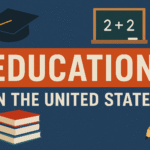Introduction
The State of Education in the United States: Challenges and Pathways to Improvement
Education in the United States is a vital part of the nation’s success and future development. It plays a critical role in shaping the skills, knowledge, and character of the next generation. However, the US education system faces several challenges, ranging from unequal access to resources and outdated curriculum to issues related to teacher shortages and the digital divide. While the nation boasts some of the best universities in the world, primary and secondary education systems vary greatly in quality depending on location and income levels. Understanding the key challenges and identifying areas for improvement is essential for a stronger future.
Unequal Access to Quality Education
One of the most serious problems in the US education system is the inequality in access to quality education. Students from wealthy families often attend well-funded schools with experienced teachers, modern facilities, and a wide range of extracurricular opportunities. In contrast, students in low-income neighborhoods may attend underfunded schools with outdated textbooks, fewer qualified teachers, and limited support services. This educational gap results in fewer opportunities for students from disadvantaged backgrounds to succeed academically and professionally.
Standardized Testing and Curriculum Issues
Another major concern is the heavy reliance on standardized testing. While tests can help assess student performance, an overemphasis on them can lead to teaching focused only on test preparation rather than critical thinking and problem-solving. Many educators argue that this testing culture puts pressure on students and teachers alike, often ignoring creativity and individual learning styles. Additionally, some critics believe that the national curriculum needs updating to better reflect real-world skills such as financial literacy, communication, and technology.
Teacher Shortages and Low Pay
The United States is currently experiencing a teacher shortage, especially in subjects like math, science, and special education. One of the main reasons for this shortage is low teacher salaries, which are often not competitive with other professions that require similar education levels. Many teachers also face high workloads, limited support, and burnout. These factors discourage talented individuals from entering or staying in the teaching profession, which in turn affects the quality of education students receive.
The Impact of Technology and the Digital Divide
Technology is changing the way students learn and interact with information. While many schools have integrated digital tools into classrooms, not all students have equal access to technology. The digital divide—especially in rural areas and low-income households—makes it harder for some students to participate fully in online learning or complete homework that requires internet access. During the COVID-19 pandemic, this issue became even more evident, highlighting the urgent need for better digital infrastructure and support.
Higher Education and Student Debt
The US is home to some of the most prestigious colleges and universities in the world, but higher education comes at a high cost. Tuition fees have increased dramatically over the past few decades, leading millions of students to take out loans. Today, student debt in the United States exceeds $1.7 trillion, affecting graduates’ financial futures and limiting their ability to buy homes, start businesses, or save for retirement. Addressing the cost of higher education is a critical step toward making college more accessible and reducing the financial burden on young Americans.
Reforms and Innovative Solutions
Despite these challenges, there are efforts underway to improve the US education system. Many states are investing in early childhood education, recognizing that learning begins long before kindergarten. Programs like universal pre-K can help close the achievement gap before it starts. Schools are also experimenting with project-based learning, STEM programs, and personalized learning strategies to better engage students.
The federal government and private organizations are working to expand internet access and provide laptops to students who need them. At the same time, some colleges are introducing free or low-cost tuition programs to help students from low-income families earn degrees without going deep into debt.
Conclusion
The US education system is at a crossroads. While it faces significant challenges, from inequality and outdated methods to affordability and digital access, there are also opportunities to create meaningful change. By investing in teachers, updating curriculum, bridging the digital divide, and making higher education more affordable, the nation can ensure that every student—regardless of background—has a fair chance at success. A strong, inclusive, and modern education system is key to a better future for the United States and its people.


